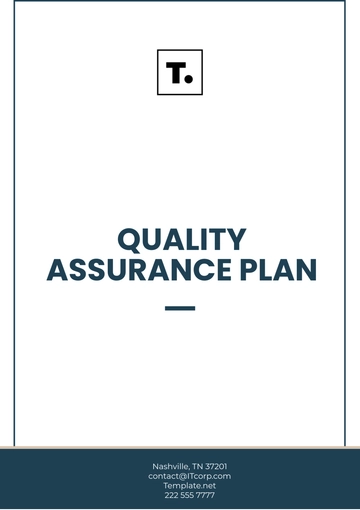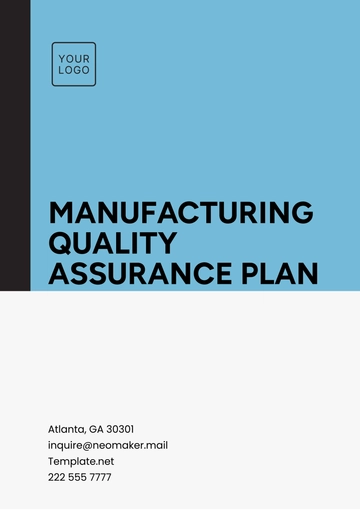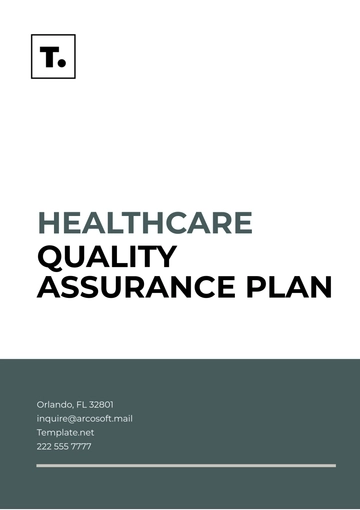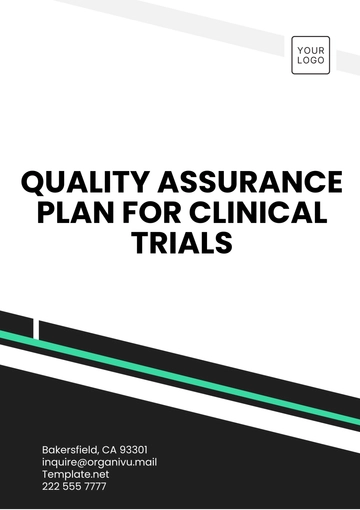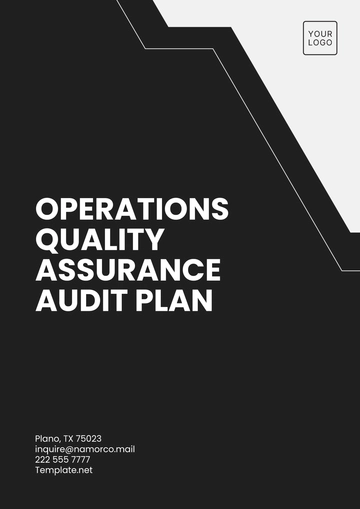Free Quality Assurance Improvement Plan

Prepared by:
[YOUR NAME]
[YOUR COMPANY NAME]
Introduction
This Quality Assurance Improvement Plan (QAIP) is designed to enhance the overall quality management system within the organization. It outlines key areas of focus, including corrective actions, process optimizations, and compliance improvements, to ensure sustained improvement in product quality, service delivery, and internal processes. The ultimate goal of this plan is to strengthen the organization's ability to meet customer expectations and comply with industry standards, fostering a culture of continuous improvement.
Objectives
Enhance Quality Control: Strengthen the processes for monitoring and ensuring product and service quality.
Ensure Compliance: Align with industry regulations and standards, including ISO, to maintain compliance.
Optimize Processes: Streamline internal processes for efficiency and effectiveness, reducing waste and improving throughput.
Improve Customer Satisfaction: Address customer feedback and complaints by making targeted improvements to products and services.
Foster a Continuous Improvement Culture: Integrate ongoing quality assessments into the organization’s day-to-day operations.
Key Areas of Focus
1. Identifying Deficiencies and Root Causes
Action Plan: Conduct regular audits and inspections to identify any quality issues in products, services, or internal processes.
Timeline: Quarterly audits and inspections.
Responsible Parties: Quality Assurance Team, Department Heads.
2. Corrective Actions and Implementation
Action Plan: Develop a corrective action plan for each identified deficiency, specifying detailed steps to rectify the issue.
Timeline: Immediate corrective actions within 30 days of identification.
Responsible Parties: Department Managers, Quality Control Officers.
3. Process Optimization
Action Plan: Implement Lean and Six Sigma principles to optimize production and service delivery processes.
Timeline: Ongoing with quarterly evaluations.
Responsible Parties: Process Improvement Team, Operations Managers.
4. Training and Capacity Building
Action Plan: Provide ongoing training for staff on quality standards, problem-solving techniques, and industry regulations.
Timeline: Bi-annual training sessions.
Responsible Parties: Human Resources, Quality Assurance Team.
5. Customer Feedback and Satisfaction
Action Plan: Collect and analyze customer feedback to identify areas for improvement in products or services.
Timeline: Continuous, with bi-monthly reviews of customer feedback.
Responsible Parties: Customer Service, Quality Assurance Team.
6. Compliance with Industry Standards
Action Plan: Perform regular internal reviews to ensure adherence to relevant quality standards, such as ISO certifications.
Timeline: Annual compliance review.
Responsible Parties: Compliance Officer, Quality Assurance Team.
Key Performance Indicators (KPIs)
Deficiency Reduction: Percentage decrease in the number of identified deficiencies or quality issues.
Customer Satisfaction Score: Improvement in customer satisfaction based on survey results.
Audit Compliance Rate: Percentage of internal audits that meet industry standard compliance requirements.
Process Efficiency: Reduction in time and resources used per production or service delivery unit.
Training Completion Rate: Percentage of staff completing scheduled training sessions.
Monitoring and Evaluation
Weekly Review Meetings: Conduct regular meetings with relevant departments to assess progress on the QAIP.
Quarterly Performance Reports: Generate reports to evaluate the progress toward achieving the objectives outlined in the QAIP.
Annual QAIP Review: A comprehensive review at the end of the year to determine overall success and to set new goals for the next year.
Conclusion
The implementation of this Quality Assurance Improvement Plan will lead to a significant enhancement in the organization's ability to consistently meet quality standards, improve internal processes, and boost customer satisfaction. By systematically addressing deficiencies, optimizing processes, and fostering a culture of continuous improvement, the organization will be better positioned to remain competitive and achieve long-term success.
- 100% Customizable, free editor
- Access 1 Million+ Templates, photo’s & graphics
- Download or share as a template
- Click and replace photos, graphics, text, backgrounds
- Resize, crop, AI write & more
- Access advanced editor
The Quality Assurance Improvement Plan Template from Template.net is fully editable and customizable to enhance your quality assurance processes. Tailor the plan to address specific quality goals, standards, and performance metrics. Editable in our AI Editor Tool, this template offers a flexible, personalized approach to improving quality assurance, ensuring consistent and reliable results.
You may also like
- Finance Plan
- Construction Plan
- Sales Plan
- Development Plan
- Career Plan
- Budget Plan
- HR Plan
- Education Plan
- Transition Plan
- Work Plan
- Training Plan
- Communication Plan
- Operation Plan
- Health And Safety Plan
- Strategy Plan
- Professional Development Plan
- Advertising Plan
- Risk Management Plan
- Restaurant Plan
- School Plan
- Nursing Home Patient Care Plan
- Nursing Care Plan
- Plan Event
- Startup Plan
- Social Media Plan
- Staffing Plan
- Annual Plan
- Content Plan
- Payment Plan
- Implementation Plan
- Hotel Plan
- Workout Plan
- Accounting Plan
- Campaign Plan
- Essay Plan
- 30 60 90 Day Plan
- Research Plan
- Recruitment Plan
- 90 Day Plan
- Quarterly Plan
- Emergency Plan
- 5 Year Plan
- Gym Plan
- Personal Plan
- IT and Software Plan
- Treatment Plan
- Real Estate Plan
- Law Firm Plan
- Healthcare Plan
- Improvement Plan
- Media Plan
- 5 Year Business Plan
- Learning Plan
- Marketing Campaign Plan
- Travel Agency Plan
- Cleaning Services Plan
- Interior Design Plan
- Performance Plan
- PR Plan
- Birth Plan
- Life Plan
- SEO Plan
- Disaster Recovery Plan
- Continuity Plan
- Launch Plan
- Legal Plan
- Behavior Plan
- Performance Improvement Plan
- Salon Plan
- Security Plan
- Security Management Plan
- Employee Development Plan
- Quality Plan
- Service Improvement Plan
- Growth Plan
- Incident Response Plan
- Basketball Plan
- Emergency Action Plan
- Product Launch Plan
- Spa Plan
- Employee Training Plan
- Data Analysis Plan
- Employee Action Plan
- Territory Plan
- Audit Plan
- Classroom Plan
- Activity Plan
- Parenting Plan
- Care Plan
- Project Execution Plan
- Exercise Plan
- Internship Plan
- Software Development Plan
- Continuous Improvement Plan
- Leave Plan
- 90 Day Sales Plan
- Advertising Agency Plan
- Employee Transition Plan
- Smart Action Plan
- Workplace Safety Plan
- Behavior Change Plan
- Contingency Plan
- Continuity of Operations Plan
- Health Plan
- Quality Control Plan
- Self Plan
- Sports Development Plan
- Change Management Plan
- Ecommerce Plan
- Personal Financial Plan
- Process Improvement Plan
- 30-60-90 Day Sales Plan
- Crisis Management Plan
- Engagement Plan
- Execution Plan
- Pandemic Plan
- Quality Assurance Plan
- Service Continuity Plan
- Agile Project Plan
- Fundraising Plan
- Job Transition Plan
- Asset Maintenance Plan
- Maintenance Plan
- Software Test Plan
- Staff Training and Development Plan
- 3 Year Plan
- Brand Activation Plan
- Release Plan
- Resource Plan
- Risk Mitigation Plan
- Teacher Plan
- 30 60 90 Day Plan for New Manager
- Food Safety Plan
- Food Truck Plan
- Hiring Plan
- Quality Management Plan
- Wellness Plan
- Behavior Intervention Plan
- Bonus Plan
- Investment Plan
- Maternity Leave Plan
- Pandemic Response Plan
- Succession Planning
- Coaching Plan
- Configuration Management Plan
- Remote Work Plan
- Self Care Plan
- Teaching Plan
- 100-Day Plan
- HACCP Plan
- Student Plan
- Sustainability Plan
- 30 60 90 Day Plan for Interview
- Access Plan
- Site Specific Safety Plan
